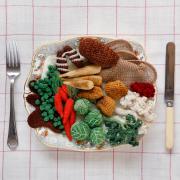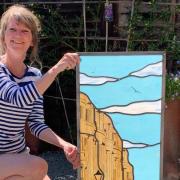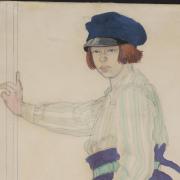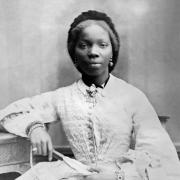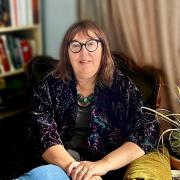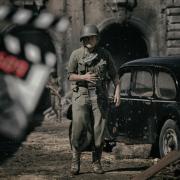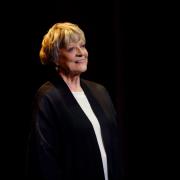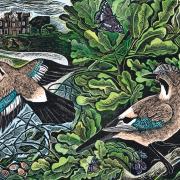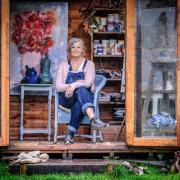When Raymond Briggs died in 2022 after a long battle with Parkinson’s, friends and neighbours inevitably began to speculate about what would become of his extraordinary house, tucked along a snaking country lane outside Ditchling.
It had been the focus of many column inches in Briggs’ lifetime, partly because he was one of the UK’s best-loved children’s authors and illustrators, and partly because of its sheer oddity. Briggs lavished all his quirks and idiosyncrasies on this tile-hung house at the foot of the Downs, and journalists had a high old time writing about them.
If ever a house was the mirror of the man, this was it. With no partner permanently in residence to check his impulses, Briggs decorated his home exactly as he wished, with no thought about home decor trends or social convention.

Who else, for example, would have turned their sitting room into a Cabinet war room by pasting a vast map of the British Isles across the ceiling? Or painted life-sized portraits of their parents on cupboard doors in the dining room? Or chalked up the dates when the chimney had been last swept down the side of their brick fireplace?
‘When I came to the house for the first time, I had no idea what to expect,’ said Steph Fuller, director of Ditchling Museum of Art + Craft, which is currently staging an exhibition, in conjunction with the Quentin Blake Centre for Illustration, featuring 30 items from Briggs’s home and more than 100 original artworks.
‘I knew there had been a valuation and the most valuable things removed, but actually it still felt as though Raymond had just walked out of the door. There were still mugs on his draining board and the house felt very inhabited. Looking at all his things and the way he collected, categorised and organised his materials, there was a real sense of his presence. It was like a little window into his brain.’

For 14 months after Briggs’ death, the house stood untouched; a haunting time capsule. Then, in January, there was a sudden flurry of activity as specialist valuers and museum staff swooped in to carefully record, catalogue and pack up the house. Some of the items went to Ditchling Museum; some into secure storage.
There was a fleeting notion that the house and its contents might be preserved in situ and turned into a museum, much like the homes of Virginia Woolf, Rudyard Kipling and Henry James elsewhere in the county. But the impracticalities of the site made this an impossibility.
‘Firstly, there’s no parking,’ said Adrian Bell, Briggs’ solicitor, who has been tasked with managing the estate. ‘And if the house is sold, the money can be put to charitable use in the way that Raymond wanted, which, for him, was a more important legacy.’

Steph nodded. ‘Also, his original artwork needed to be in a controlled environment to preserve it. With the best will in the world, the house was not the best environment.
‘And just on a practical level, running an artist’s house museum is a tricky financial proposition. The house is small, so you couldn’t have 100,000 visitors a year because you’d never get them through the place. And if you did, they would destroy it. From a museum perspective, what you really want is for his things to go into public collections so that researchers can access them for books or creative research.’
I had been invited to the house, at the behest of Ditchling Museum, to view its remarkable contents before the property was emptied. Work was well underway when Adrian and Steph greeted me in the sitting room, already strewn with boxes.

The house is expected to go on the market soon, said Adrian. Briggs left nearly all his £6m estate to charity, and his posthumous royalties will support his most cherished causes – Parkinson’s UK; Blood Cancer UK and Rethink Mental Illness – in perpetuity. ‘It’s not quite JM Barrie’s great legacy to Great Ormond Street Hospital, but it’s in the same vein,’ he said.
Ephemera from the house, including Briggs’ artwork and papers, will go to various institutions, including a local archive provider, alongside important books from his vast library. But first, some of it is currently on display at Ditchling, including work from several of Briggs’ best-loved books – Father Christmas (1973), Fungus the Bogeyman (1977), The Snowman (1978) and When the Wind Blows (1982), plus the autobiographical novel Ethel and Ernest (1998). Also on show are his drawings, hand-lettered typography and page designs.
‘Raymond would famously opine about how you shouldn’t show artwork for books because the book was the thing,’ said Steph. ‘But actually, his preparatory drawings weren’t roughs. They were highly worked-up original artworks. They’re fascinating to see because many of them are annotated with his notes, revealing how long they took him or what he’d been doing at the time.’

Briggs bought the house with his wife, Jean Taprell Clark, in 1967, drawn by the stunning downland views. He was teaching part-time at Brighton College of Art and living in Burgess Hill. One afternoon, they took a drive through Ditchling and noticed a for sale sign in a quiet country lane. Seduced by the rural setting and the back garden which sloped straight on to the Downs, Briggs snapped it up for £5,400.
As I walked through each crowded room, Briggs’ hoarding tendencies were inescapable. Every space, including the kitchen, was bursting with books, and the walls covered in pictures, often affectionate pastiches of his most famous works by friends and fellow artists.
I spotted a lively Private Eye cover by Brighton-based cartoonist Steve Bell which desecrated the purity of The Snowman by depicting the then prime minister, John Major, as ‘The Snoreman’, complete with Y-fronts (for many years Bell depicted Major as a hapless Superman). Bell gave the original to Briggs by way of an apology for his sacrilege. It’s included in the exhibition.
Every surface was also covered with memorabilia. The Snowman waved multiple times from a clutch of snow globes mushrooming on a windowsill. In the kitchen, a Spartan testament to Briggs’ monkish existence, there was enough Snowman china displayed on dusty open shelving to open a small ceramics museum.
‘You can see that he must have been sent a copy of every mug and figurine ever licensed,’ said Steph. Briggs, whose frugality was legendary and who clearly knew a good thing when he saw one, had even repurposed a roll of Snowman toilet paper by wedging it on a kitchen-roll holder.
My eyes roved over surfaces dotted with curios collected from junk shops; there was a knowing delight in the kitsch, the scatological and the downright bawdy. I spotted a collection of ceramic salt and pepper shakers shaped like women’s breasts and a highly suggestive tree trunk.

His catholic book tastes were greatly in evidence, too; poetry predominated. I noted the collected works of Philip Larkin and novels by Thomas Hardy. ‘They were both miserable people, which fits in with me,’ he once told me.
That unhappiness stemmed from his tragic early life; the house emitted a palpable sense of solitariness. Briggs lost his wife and parents within 18 months, leaving him, an only child, alone in the world until he met his long-term partner Liz Benjamin (he and Jean were unable to have children due to her schizophrenia). Overwhelmed with grief, he immersed himself in his work and retreated to the emotional security of his childhood.
Even after meeting Liz, Briggs continued to keep a separate house, often explaining that there wasn’t enough space at her home near Plumpton for him to be there full-time – she had two children and kept lodgers. One suspects he also needed his own environment in which to work.

Ironically, after her death, Briggs did move into Liz’s house. By then his own home had no doubt become wholly impractical, particularly with his advanced Parkinson’s. In all likelihood, he had also been pushed out by the ever-burgeoning Snowman memorabilia.
Continuing my house tour, I was met by the famous cupboard door portraits of his parents, Ethel Bowyer, a former lady’s maid, and Ernest Briggs, a milkman. They have been reinstalled in the exhibition. Briggs told me he painted them while waiting for his publishers to green-light his greatest work, Ethel and Ernest. The habitual sight of his parents must have been a comforting presence.
As if to prove it, I spied his parents again in a framed photo on his drawing desk in his upstairs studio. As I took it all in, Matt Barker, an installation technician for Ditchling Museum, started clearing the surface of Briggs’ old pine desk, dominated by a sloping drawing board, a large Anglepoise lamp and a neat assortment of artists’ materials.

Poignantly, when I returned a few minutes later, the desk was bare, the last thing to go – that framed portrait of a young Ethel and Ernest dressed in their Sunday best. But never fear – you can still see it all as it was. The desk is also now on display at Ditchling.
As I left, I met Matt again on the stairs. We started chatting about Briggs’ creative legacy and what a privilege it had been viewing his home firsthand.
‘We all grew up with The Snowman,’ he said. ‘My sister watched it endlessly on VHS and then, when my granny went into an old people’s home, we bought a copy of the book especially for her. She used to leaf through it endlessly. She was more than 100 by then, and had dementia, but it gave her comfort.’ He paused to take a breath. ‘I’m getting quite emotional thinking about Granny and how much she loved The Snowman.’
· Bloomin’ Brilliant: The Life and Work of Raymond Briggs runs at Ditchling Museum of Art + Craft until 27 October; ditchlingmuseumartcraft.org.uk/book-your-ticket/




